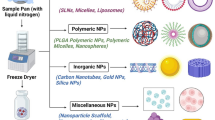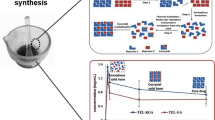Abstract
Apremilast (APST) is an effective inhibitor of phosphodieasterase 4 (PDE4) which is the first oral drug for the treatment of adult patients with active psoriatic arthritis. However, Apremilast’s low solubility restricts its dissolution and bioavailability. In this study, APST solid dispersion with D-α-tocopherol polyethylene glycol 1000 succinate (TPGS) and Poly(1-vinylpyrrolidone-co-vinyl acetate) (PVPVA) was developed to improve the dissolution and bioavailability of APST by spray drying. A series of TPGS were synthesized to elucidate the effect of the ratio of monoester to diester on solubilizing capacity. X-ray powder diffraction (XRPD), differential scanning calorimetry (DSC), and Fourier transform infrared spectrophotometry (FT-IR) were used to characterize the solid dispersion, and the results showed that APST was amorphous in solid dispersion. In vitro dissolution study showed that the dissolution rate of solid dispersion in phosphate buffered saline (pH 6.8) was remarkably increased, reaching a release of 90% within 10 min. Moreover, in vivo pharmacokinetics study revealed that the bioavailability of solid dispersion in rats had significant improvement. In particular, its Cmax and AUClast were nearly 22- and 12.9-fold greater as compared to APST form B, respectively. In conclusion, APST solid dispersion with TPGS and PVPVA is an alternative drug delivery system to improve the solubility and oral bioavailability of APST.








Similar content being viewed by others
Change history
14 June 2021
A Correction to this paper has been published: https://doi.org/10.1208/s12249-021-02046-2
References
Schett G, Sloan SV, Stevens MR, Schafer P. Apremilast: a novel PDE4 inhibitor in the treatment of autoimmune and inflammatory diseases. Ther Adv Musculoskel. 2010;2(5):271–8.
FDA (2014). US Department of Health and Human Services, Food and Drug Administration Centre for Drug Evaluation and Research (CDER), Guidance for Industry, Clinical Pharmacology and Biopharmaceutics review, March 2014.
Schafer P. Apremilast mechanism of action and application to psoriasis and psoriatic arthritis. Biochem Pharmacol. 2012;83(12):1583–90.
EMA. Assessment report on Otezla (apremilast). CHMP, EMA. 2014;2014.
Jinno J, Kamada N, Miyake M, et al. Effect of particle size reduction on dissolution and oral absorption of a poorly water-soluble drug, cilostazol, in beagle dogs. J Control Release. 2006;111(1-2):56–64.
Wang FY, Zhang Q, Zhang ZY, Gong XY, Wang JR, Mei XF. Solid-state characterization and solubility enhancement of apremilast drug-drug cocrystals. CrystEngComm. 2018;20:5945–8.
Rudrangi SR, Trivedi V, Mitchell JC, Wicks SR, Alexander BD. Preparation of olanzapine and methyl-beta-cyclodextrin complexes using a single-step, organic solvent-free supercritical fluid process: an approach to enhance the solubility and dissolution properties. Int J Pharm. 2015;494:408–16.
Madan JR, Pawar AR, Patil RB, Awasthi R, Dua K. Preparation, characterization and in vitro evaluation of tablets containing microwave-assisted solid dispersions of apremilast. Polim Med. 2018;48(1):17–24.
Bikiaris DN. Solid dispersions, part I: recent evolutions and future opportunities in manufacturing methods for dissolution rate enhancement of poorly water-soluble drugs. Expert Opin Drug Deliv. 2011;8(11):1501–19.
Singh A, Van den Mooter G. Spray drying formulation of amorphous solid dispersion. Adv Drug Deliv Rev. 2016;100:27–50.
Li J, Patel D, Wang G. Use of spray-dried dispersions in early pharmaceutical development: theoretical and practical challenges. AAPS J. 2017;19:321–35.
He Y, Ho C. Amorphous solid dispersions: utilization and challenges in drug discovery and development. J Pharm Sci. 2015;104:3237–58.
Janssens S, Nagels S, Armas H, Autry W, Schepdael A, Van den Mooter G. Formulation and characterization of ternary solid dispersions made up of Itraconazole and two excipients, TPGS 1000 and PVPVA 64, that were selected based on a supersaturation screening study. Eur J Pharm Biopharm. 2007;69(1):158–66.
Shin SC, Kim J. Physicochemical characterization of solid dispersion of furosemide with TPGS. Int J Pharm. 2003;251(1-2):79–84.
Chen W, Yu-Qiang Miao YQ, Fan DJ, et al. Bioavailability study of berberine and the enhancing effects of TPGS on intestinal absorption in rats. AAPS PharmSciTech. 2011;12(2):705–11.
Aggarwal N, Goindi S, Mehta SD. Preparation and evaluation of dermal delivery system of griseofulvin containing vitamin E-TPGS as penetration enhancer. AAPS PharmSciTech. 2012;13(1):67–74.
Liu YK, Sun CY, Li WJ, et al. Preparation and characterization of syringic acid-loaded TPGS liposome with enhanced oral bioavailability and in vivo antioxidant efficiency. AAPS PharmSciTech. 2019;20(3):20–98.
Dintaman JM, Silverman JA. Inhibition of P-glycoprotein by d-alphatocopheryl polyethylene glycol 1000 succinate (TPGS). Pharm Res. 1999;16:1550–6.
Bogman K, Erne-Brand F, Alsenz J, Drewe J. The role of surfactants in the reversal of active transport mediated by multidrug resistance proteins. J Pharm Sci. 2003;92:1250–61.
Cornaire G, Woodley J, Hermann P, Cloarec A, Arellano C, Houin G. Impact of excipients on the absorption of P-glycoprotein substrates in vitro and in vivo. Int J Pharm. 2004;278:119–31.
Rege BD, Kao JP, Polli JE. Effects of nonionic surfactants on membrane transporters in Caco-2 cell monolayers. Eur J Pharm Sci. 2002;16:237–46.
Alhijjaj M, Belton P, Qi S. A multi-technique characterization of the stability of surfactant containing solid dispersions based buccal patches prepared by hot melt injection moulding. Int J Pharm. 2017;528(1-2):547–62.
Ahn JS, Kim KM, Ko CY, Kang JS. Absorption enhancer and polymer (Vitamin E TPGS and PVP K29) by solid dispersion improve dissolution and bioavailability of eprosartan mesylate. Bull Kor Chem Soc. 2011;32(5):1587–92.
Chen YC, Ho HO, Chiou JD, Sheu MT. Physical and dissolution characterization of cilostazol solid dispersions prepared by hot melt granulation (HMG) and thermal adhesion granulation (TAG) methods. Int J Pharm. 2014;473:458–68.
Xue X, Chen GG, Xu XQ, et al. A combined utilization of plasdone-S630 and HPMCAS-HF in ziprasidone hydrochloride solid dispersion by hot-melt extrusion to enhance the oral bioavailability and no food effect. AAPS PharmSciTech. 2019;20:37–48.
He HB, Yang R, Tang X. In vitro and in vivo evaluation of fenofibrate solid dispersion prepared by hot-melt extrusion. Drug Dev Ind Pharm. 2010;36(6):681–7.
Fule RA, Meer TS, Sav AR, Amin PD. Artemether-soluplus hot-melt extrudate solid dispersion systems for solubility and dissolution rate enhancement with amorphous state characteristics. Aust J Pharm. 2013:1–15.
Goddeeris C, Willems T, Van den Mooter G. Formulation of fast disintegrating tablets of ternary solid dispersions consisting of TPGS 1000 and HPMC 2910 or PVPVA 64 to improve the dissolution of the anti-HIV drug UC 781. Eur J Pharm Sci. 2008;34(4-5):293–302.
Hou HH, Rajesh A, Pandya KM, et al. Impact of method of preparation of amorphous solid dispersions on mechanical properties: comparison of coprecipitation and spray drying. J Pharm Sci. 2019;(108):870–9.
Lee YC, McNevin M, Ikeda C. Combination of colloidal silicon dioxide with spray-dried solid dispersion to facilitate discharge from an agitated dryer. AAPS PharmSciTech. 2019;20:182–98.
Peng TT, She YJ, Wu CB, et al. Influence of polymers on the physical and chemical stability of spray-dried amorphous solid dispersion: dipyridamole degradation induced by enteric polymers. AAPS PharmSciTech. 2018;19(6):2620–8.
Cho Y, Ha ES, Baek IN, et al. Enhanced supersaturation and oral absorption of sirolimus using an amorphous solid dispersion based on Eudragit® E. Molecules. 2015;20:9496–509.
Marasinia N, Trana TH, Poudela BK, et al. Fabrication and evaluation of pH-modulated solid dispersion for telmisartan by spray-drying technique. Int J Pharm. 2013;441(1-2):424–32.
Chen J, Ormes JD, Higgins JD, Taylor LS. Impact of surfactants on the crystallization of aqueous suspensions of celecoxib amorphous solid dispersion spray dried particles. Mol Pharm. 2015;12(2):533–41.
Jang DJ, Sim T, Oh E. Formulation and optimization of spray-dried amlodipine solid dispersion for enhanced oral absorption. Drug Dev Ind Pharm. 2013;39(7):1133–41.
Goddeeris C, Willems T, Houthoofd K, Martens JA, Van den Mooter G. Dissolution enhancement of the anti-HIV drug UC 781 by formulation in a ternary solid dispersions with TPGS 1000 and Eudragit E100. Eur J Pharm Biopharm. 2008;70(3):861–8.
Song IS, Cha JS, Choi MK. Characterization, in vivo and in vitro evaluation of solid dispersions of curcumin containing D-α-tocopheryl polyethylene glycol 1000 succinate and mannitol. Molecules. 2016;21(10):1386–401.
Feng DS, Peng TT, Huang ZW, et al. Polymer-surfactant system based amorphous solid dispersion: precipitation inhibition and bioavailability enhancement of itraconazole. Pharmaceutics. 2018;10(2):53–67.
Moneghini M, Zordi ND, Solinas D, Macchiavelli S, Princivalle F. Characterization of solid dispersions of itraconazole and vitamin E TPGS prepared by microwave technology. Future Med Chem. 2010;2(2):237–46.
Hurley D, Potter CB, Walker GM, Clement L. Higginbotham. Investigation of ethylene oxide-co-propylene oxide for dissolution enhancement of hot-melt extruded solid dispersions. J Pharm Sci. 2018;107:1372–82.
Zhang ZH, Chen Y, Deng J, et al. Solid dispersions of berberine-phospholipid complex/TPGS1000/SiO2: preparation, characterization and invivo studies. Int J Pharm. 2014;465(1-2):306–16.
Fan WL, Zhang XY, Zhu WJ, Di LQ. The preparation of curcumin sustained-release solid dispersion by hot-melt extrusion-II. Optimization of preparation process and evaluation in vitro and in vivo. J Pharm Sci. 2020;109:1253–60.
Mohd AB, Vemula SK. Formulation and pharmacokinetics of vitamin E TPGS melt dispersion granules: an approach to improve oral delivery of flurbiprofen. J Bioequivalence Bioavailab. 2016;8(2):89–94.
Kim DS, Choi JS, Kim DW, et al. Comparison of solvent-wetted and kneaded L-sulpiride-loaded solid dispersions: powder characterization and in vivo evaluation. Int J Pharm. 2016;511(1):351–8.
Andey T, Sudhakar G, Marepally S, Patel A, Banerjee R, Singh M. Lipid nanocarriers of a lipid-conjugated estrogenic derivative inhibit tumor growth and enhance cisplatin activity against triple-negative breast cancer: pharmacokinetic and efficacy evaluation. Mol Pharm. 2015;12(4):1105–20.
Funding
We acknowledge the financial support from the State Key Laboratory for Anti-Infective Drug Development (Sunshine Lake Pharma Co., Ltd.), (No. 2015DQ780357).
Author information
Authors and Affiliations
Corresponding authors
Ethics declarations
Conflict of interest
The authors declare no competing interests.
Additional information
Publisher’s Note
Springer Nature remains neutral with regard to jurisdictional claims in published maps and institutional affiliations.
The original online version of this article was revised to add the additional corresponding email address quanguilan@jnu.edu.cn to the article.
Supplementary Information
ESM 1
(DOC 258 kb)
Rights and permissions
About this article
Cite this article
Yang, L., Wu, P., Xu, J. et al. Development of Apremilast Solid Dispersion Using TPGS and PVPVA with Enhanced Solubility and Bioavailability. AAPS PharmSciTech 22, 142 (2021). https://doi.org/10.1208/s12249-021-02005-x
Received:
Accepted:
Published:
DOI: https://doi.org/10.1208/s12249-021-02005-x




